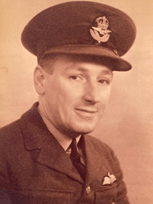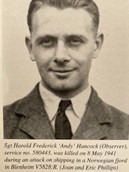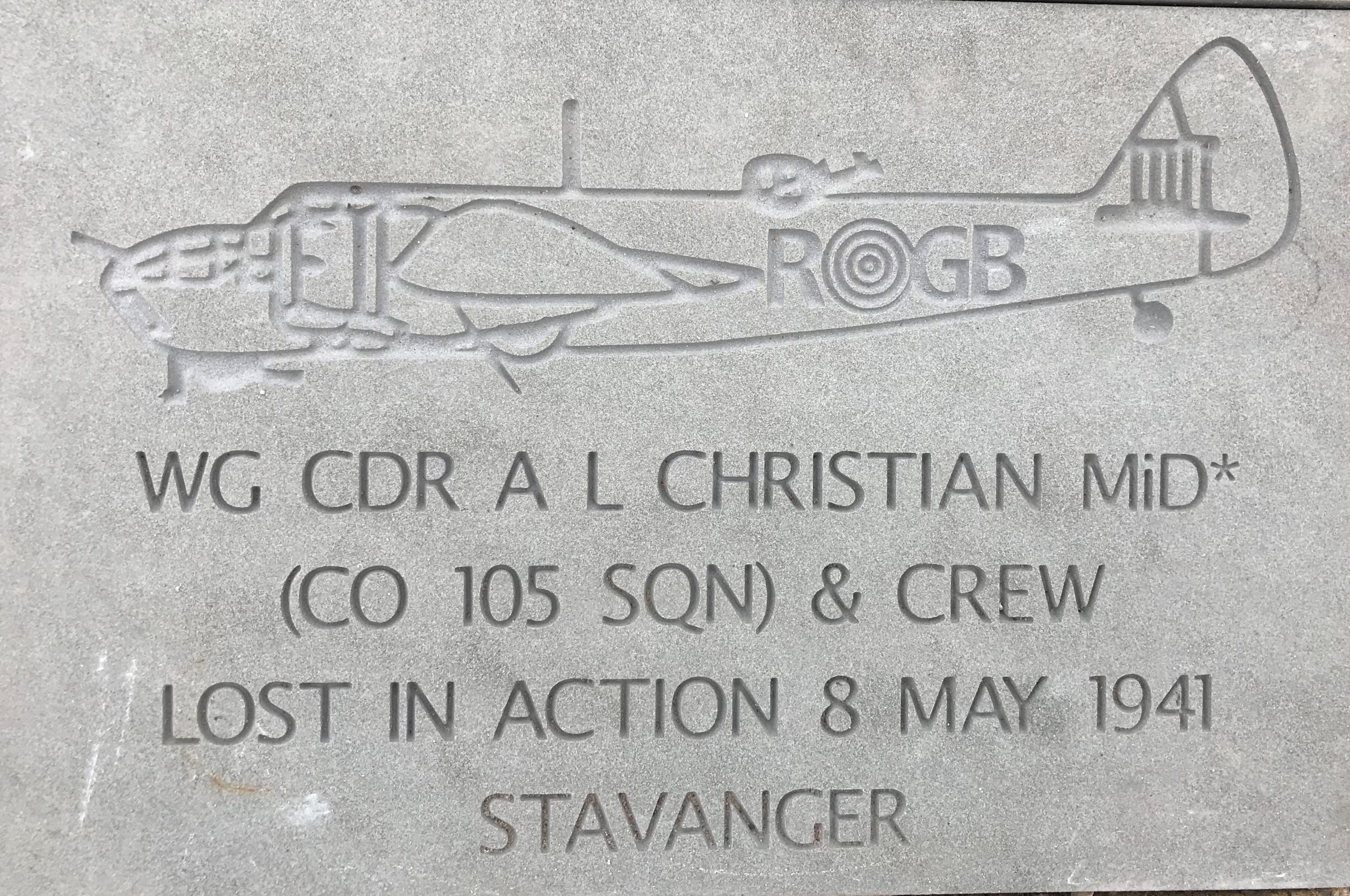Wing Commander A L Christian MiD* RAF – 1906 – 1941
Arnold Louis Christian was born in Hove, grew up in Birkenhead where his family operated their business, and educated as a boarder at Ruthin Public School, (founded in 1284 almost 150 years before Eton College).
After gaining Higher School Certificate he began work in the family business and, in 1929, went to Newcastle Upon Tyne to open a new branch of the business. There, two significant life events occurred. He met the girl who was to become his wife and he entered a newspaper competition winning first prize – a half hour flying lesson. Smitten by both, he left the business – much to the annoyance of the family – and was commissioned into the RAF in October 1930.
Upon completion of flying training at No 3 FTS, (Flying Training School), RAF Grantham, he was posted to No 54 Squadron, RAF Hornchurch. As a member of 54 Sqn he participated in the famous Hendon Air Displays, hugely popular in the 1930’s, was married, and two of his three children were born, (both boys, they too were to join the RAF, followed by two of his grandsons).

Now a Flight Lieutenant, he was posted, unaccompanied, for eight months over 1935-36 to Ed Damer and Atbara in the British Protectorate of Sudan. On return it was to 218 (Bomber) Squadron, RAF Upper Heyford, and selection for instructor training at CFS, (Central Flying School), RAF Upavon. On the evening of 28th June 1937, whilst in the station cinema, a message was flashed onto the screen – ‘F/L Christian you have a baby daughter’ – home at Upper Heyford, his third child had been born. From CFS it was briefly to No 6 FTS, RAF Netheravon, and then on to No 5 FTS, RAF Sealand, as a flying instructor.
Promoted Squadron Leader on 21 November 1938, there then followed 10 months at RAF Debden before a posting to RAF Bicester. Briefly to No 108 Sqn and then No 104 Sqn as Commander of ‘B’ Flight. Both squadrons operated the Bristol Blenheim light bomber.
On 25th October 1939, as second pilot/navigator to Major Jim Cordes, chief test pilot for Handley Page, he flew on the maiden flight from Bicester of their new heavy bomber the ‘Halifax’. In April 1940, 104 & 108 merged to form No 13 OTU, (Operational Training Unit), where he served as a Flying Instructor.
On 24th November 1940 it was to 105 Sqn, ( No 2 Group, Bomber Command), RAF Swanton Morley. Stuart R Scott, in his book Battle-Axe Blenheims No 105 Squadron at war 1940-1, records ‘Well known to many of the crews as an instructor, S/L Arnold Christian had arrived to become Flight Commander of ‘B’ Flight, and was ultimately to prove a very popular CO’.
One month later, on Christmas Eve, he was promoted Wing Commander and became the squadron’s commanding officer.
At this time the squadron was engaged largely on night operations against various industrial targets, and specific oil refineries, and these continued into 1941. On 4th February, he led the squadron to attack docks at Ostend, Dunkirk and Dieppe and also on several airfields in Northern France. All targets were successfully attacked without loss.
On 30th March, lifting off at 20.18 hours as part of a much larger mixed force, he led 5 Blenheims, from RAF St. Eval, Cornwall, to attack the port of Brest where the German battlecruisers, Scharnhorst and Gneisenau, responsible for inflicting huge losses on British shipping, were docked. All bombs were delivered in the target area and all crews survived the attack. So too did the enemy ships!
On the 9th April the squadron received orders to convert to daytime operations and on the 13th the daylight anti-shipping role began. The task for No 2 Group and its Blenheim squadrons was to seal the North Sea to enemy shipping.
The crews now had to learn a new skill and Arnold Christian was hugely instrumental in this, as remembered by S/L David Bennett, who paid tribute in 2 Group RAF by Michael J.F. Bowyer:
‘Arnold Christian, an A1 Category CFS (Central Flying School) instructor, could fly a Blenheim better than most and inspired us all with his skill and leadership. He had been responsible for our rapid conversion from night bombing to daylight low-level operations in April 1941. Training was intense as Christian encouraged us to fly accurately over the sea at 50ft and lower. ‘The lower the better’, were his words, and ‘effective jinking manoeuvres near the deck (sea level) can get you out of trouble in the target area’. He was right. A Blenheim could be thrown around, and his example inspired us all. Our squadron commander was a stubborn never-say-die character with inborn leadership of a somewhat rebellious nature, traits possessed by so many 2 Group squadron commanders’.
‘Beat’ areas were established along coasts from southern Norway to the Low Countries and these were the Blenheim’s new hunting grounds. Blenheim squadrons of 2 Group were detached, in around two weeks rotation, to RAF Lossiemouth, Scotland, to operate Norwegian coastal beats. On 5th May, 1941, it was the turn of 105 Sqn. 17 Blenheims moved from Swanton Morley to Lossiemouth for their rotational stint.
At 05.10 hours on Thursday, 8th May 1941, in Blenheim V5828:R, Wg Cdr Arnold Christian and his crew, F/Sgt Harold Frederick ‘Andy’ Hancock (Observer) and Sgt G. Wade (Wireless Op/Air Gunner), lifted off leading 5 other aircraft and headed for the beat 2 area off the Norwegian coast at Stavanger.
As recorded in Battle-Axe Blenheims by Stuart R. Scott, four of the aircraft saw no shipping and returned to base. Aircraft T2118:E (P/O Buckley) was at No 2 position (on the right) of the CO’s aircraft when, as further recorded, a convoy of twenty vessels appeared at the entrance to Hafrsfjord, west of Stavanger. Two merchant ships were singled out one a merchantman, the other identified as an 800-ton flak ship. When the first merchant vessel was last seen, it was down by the stern, billowing smoke high into the air. During his run-in for a beam attack on the flak ship, P/O Buckley realised that W/C Arnold Christian and his crew, had not re-appeared on his port side. Their Blenheim was last seen with the port engine on fire.
Herr Leidland, a fisherman, saw the aircraft crash into the water, and he later retrieved a flying boot from the sea; it contained a leather tag with F/Sgt Hancock’s name on it. They had crashed south of the entrance to Hardangerfjorden, north of Stavanger.
The loss of the CO hit squadron morale very badly, and was well remembered by the then S/L David Bennett who paid the following tribute also in Bowyer’s 2 Group RAF, Arnold’s sense of fun and his good, dry humour, added to his superb airmanship, made 105 a good squadron!

Photograph: Battle-Axe Blenheims – Stuart R Scott
From Battle-Axe Blenheims, Sgt Geoffrey Rowland (WOp/AG) commented W/C Arnold Christian was one of the finest COs one could wish to serve under, and Sgt Wood (Pilot), we all remembered Arnold Christian joining in with the boys, playing rugger with the adjutant’s hat.
The above is the briefest story of a husband, a father, a regular officer in the RAF. More than that, it is also the story of so many Bomber Command aircrew – 55,000 – who lost their lives in WW2. Stuart Scott sums it up well in the introduction to his book, Battle-Axe Blenheims. ‘The Blenheim crews suffered grievous losses throughout the war, but their resolve, their firm belief in the right of their tasks, and their absolute belief in their leadership, remained unswayed’.
105 Squadron’s motto Fortis in Proeliis translates as ‘Valiant in Battles’
There can be no more fitting epitaph for a Blenheim crew.
To order your stone and preserve the memory of your loved one click here
